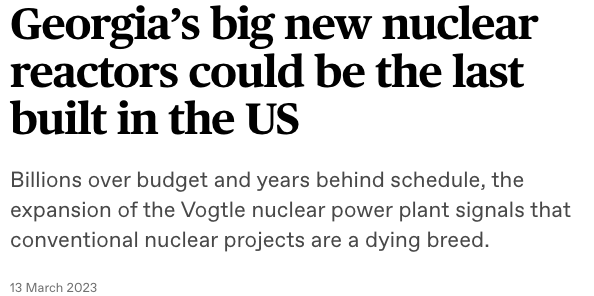Last week, I read the following headline…

The author of this article was referring to the first new nuclear reactor built in the U.S. in 30 years: Plant Vogtle.
This is one of two new nuclear power units that are expected to begin operations as early as May. Once up and running, these two power plants will provide enough electricity to power 500,000 homes and businesses.
Now, the headline of this article is a bit misleading in that this new nuclear reactor is definitely not the last nuclear reactor to be built in the U.S.
It’s just the last of this particular type of nuclear reactor, which is based on antiquated technology and, like conventional nuclear power plants before it, came in way over budget and took much longer to build than initially promised.
Truth is, today’s fleet of nuclear power plants were extremely cost-prohibitive to build in the first place, and the only reason they were built was because Uncle Sam ponied up some very generous welfare checks to get them up and running.
I don’t say this to criticize the benefits of nuclear power, by the way. It’s merely an observation of truth. Our analysts have traveled the world over, dedicated to finding the best and most profitable investments in the global energy markets. All you have to do to join our Energy and Capital investment community is sign up for the daily newsletter below.The Best Free Investment You’ll Ever Make
According to Taxpayers for Common Sense, a nonpartisan federal budget watchdog organization, the nuclear energy industry in the U.S. has benefited from cradle-to-grave subsidies throughout history:
In recent decades, as policymakers have sought to incentivize or support new, more sustainable technologies that will also reduce carbon emissions, nuclear continues to receive federal support, despite its prohibitive costs and history of long delays. These subsidies have allowed nuclear to remain competitive and maintain a strong market position in the face of growing pressure from renewable sources.
The reason these two new nuclear power plants are the first to be built in 30 years isn’t because there’s no appetite for nuclear power. It’s because they’re just too damn expensive.
Or at least, they were.
You see, there’s a new breed of nuclear reactor that’s now being developed for a rapid expansion of nuclear power across the U.S., and this reactor can be built and operated at a fraction of the cost of traditional nuclear power.

And the best part is the fuel required to power this reactor, called "Tri-Fuel 238," is 40,835 times more powerful than natural gas, 67,389 times more potent than gasoline, and coal, solar, and wind can’t even come close.
Make no mistake: This is the future of nuclear power — and if you don’t believe it, ask yourself why some of the world’s most prestigious hedge funds and investment banks have already ponied up for a piece of the action.
I’m talking about the likes of Rockefeller Capital Management, Morgan Stanley, Merrill Lynch, Bank of America, and Vanguard Group — certainly not bad company to be in.
That's why I’m including this short presentation on "Tri-Fuel 238" and this new breed of nuclear reactors.
There’s literally tens of billions of dollars up for grabs here. The big banks and hedge funds are sure as hell wetting their beaks on this thing — you might as well too. Here’s how.
To a new way of life and a new generation of wealth… Jeff Siegel Jeff is an editor of Energy and Capital as well as a contributing analyst for New World Assets. Want to hear more from Jeff? Sign up to receive emails directly from him ranging from market commentaries to opportunities that he has his eye on.


 @JeffSiegel on Twitter
@JeffSiegel on Twitter
